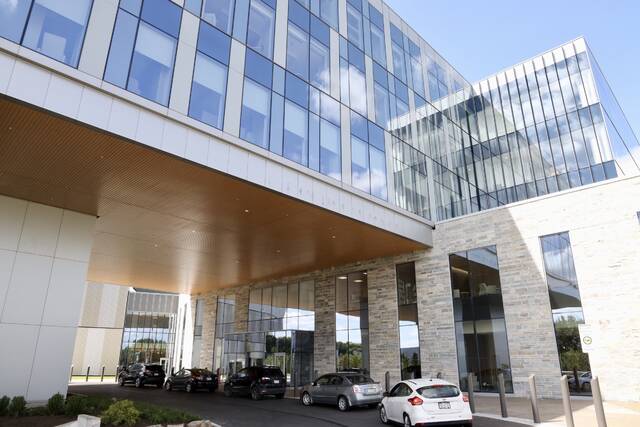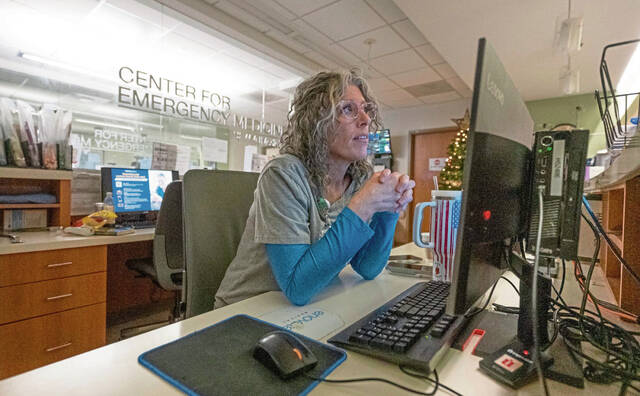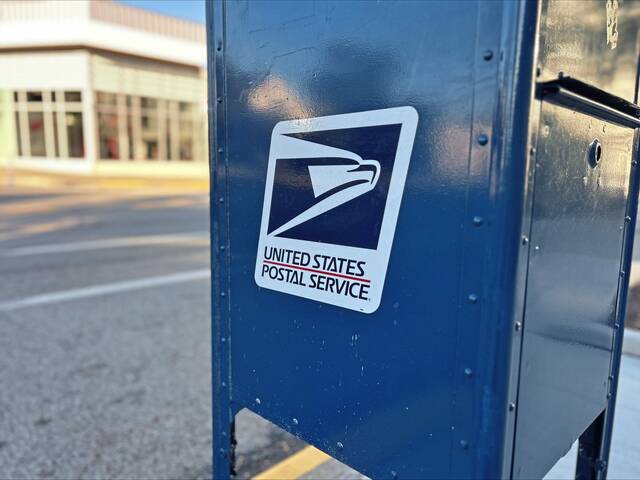Despite confronting spiking staffing costs while covid-19 hospitalizations climb, Allegheny Health Network’s leaders say they’re confident in the 14-hospital system’s ability to treat influxes in patients as the pandemic rages on.
“We have capacity and we’ve got the equipment that we need,” AHN Chief Financial Officer James Rohrbaugh told the Tribune-Review by phone Tuesday, referring to everything from having enough ventilators to ample supply of personal protective equipment. “Should we continue to have some increases in covid-19 patients, we’re well-positioned to be able to accommodate them.”
About 270 people are now hospitalized for severe covid-19 symptoms or life-saving treatment across the AHN system — up from closer to 250 covid hospitalizations earlier this month, 50 in August and as few as six patients at the start of July, AHN officials report. A recent internal review of nearly 500 covid-19 patients found that more than 90% of hospitalizations involved unvaccinated patients.
The system’s trend is in line with the looming covid surge that Westmoreland County-based Excela Health’s top doctor warned about last week.
Labor, supply costs get pricier
Like other health systems in the region and nationwide, AHN continues to grapple with inflated costs amid staffing shortages and global supply-chain woes.
“When I talk to my peers across the country, we’re all dealing with the same set of issues,” Rohrbaugh said. “One, there’s a labor shortage. We talk a lot about nursing … but we’ve got a lot of other areas where there’s labor pressures — service areas as well. We are seeing an increase in salary and benefits expenses … things like extra supplemental pay, contract labor. And there continues to be financial pressure on the supply chain.”
Rohrbaugh and many fellow health executives predicted that multi-thousand-percent price increases for supplies that emerged early on during the pandemic would fade by now.
“The price point hasn’t come down,” Rohrbaugh said. “We have not had problems getting PPE — we’ve stayed on top of making sure what we need to have. But the pricing has stayed high. And it looks like unfortunately that will continue to be the case for a while.”
Outpatient volumes up by 44%, ER visits up by 16%
The lingering challenges of supply and labor cost surges aren’t enough to hamper Rohrbaugh’s optimism in AHN’s ability to weather coming months and gain stronger financial footing.
Total revenue for AHN for the first nine months of this year amounted to $3 billion, up from $2.6 billion during the same period in 2020, the system’s unaudited third-quarter financial statements show. Third-quarter operating losses totaled $16.6 million, for a net deficit of $17.2 million between July and September.
Through the first nine months of the year, operating losses totaled $41.7 million — compared to a loss of $151.5 million during the same period last year, the self-reported records show.
“Our operating margin has improved by about $110 million, and that’s really driven by volumes,” Rohrbaugh said. “We see volume improving and with that, we’ve certainly seen the financials improve.”
Among metrics that are better than this time last year:
• Outpatient services have increased the most — by about 44%.
• Surgical cases and emergency department visits both have increased by 16%.
• Hospital admissions and observations are up by 6.4%.
Births are up by about 1.5% from the same period in 2020, and the 100th baby was recently born at the newly opened 160-bed AHN Wexford hospital in Pine.
Officials also cited significant upticks in the past four months of use of neighborhood-based “mini hospitals” with 24-hour emergency rooms that were built and opened during and leading up to the pandemic. The McCandless Neighborhood Hospital opened in December 2019, Hempfield Neighborhood Hospital opened in January 2020, Brentwood Neighborhood Hospital opened in March 2020 and Harmar Neighborhood Hospital opened in September 2020.
“Our neighborhood hospital strategy is working out well,” Rohrbaugh said.
Though across-the-board increases in volume are encouraging, he said, “We’re still not back to where we were pre-pandemic.”
Before covid-19 struck, AHN had been reporting quarter after quarter of record-high revenue gains.
RELATED: Highmark boasts $490M operating gain in 2020 — better than pre-pandemic
AHN’s investment portfolio netted $28.3 million in earnings from January to September, compared to $21.2 million over the same period in 2020.
Allegheny Health Network is the provider arm to parent company Highmark Health, which includes Highmark insurance and other businesses.
In August — as AHN took in out-of-state patients as covid surges overwhelmed Texas, Florida and Oklahoma— Highmark Health CEO David Holmberg said that the system was on track to advance ambitious growth and investment plans, saying that responding to the pandemic “has made us a better organization.”
Highmark Health has net assets topping $10 billion and ended 2020 nearly $500 million in the black.
In addition to federal relief in the form of loans and grants, insurance gains via fewer payouts during the early pandemic helped offset hospital losses during covid-spurred restrictions on non-urgent procedures.
RELATED: Why ‘bailed-out’ hospital giants like UPMC thrived in 2020 while others floundered








